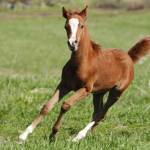Multiple Factors May Contribute to Subchondral Cysts in Foals

Subchondral cysts often occur in the medial femoral condyle (MFC) within the stifle joint of horses. The medial and lateral femoral condyles are located at the end of the femur that articulates with the tibia in the hindlimb. Subchondral cysts can cause pain, lameness, and reduced performance, and often require either medical or surgical intervention, which can be costly. How these lesions develop in young horses, however, remains unclear but could involve focal trauma to the joint surface, subchondral vascular damage, or a failure of endochondral ossification, during which cartilage develops into bone.
Because of the profound clinical significance MFC cystic lesions have on performance, research continues to focus on causes of these cysts so that preventative measures can be identified.
Veterinary researchers recently conducted a radiograph-based study that measured various parameters in foal stifles.* The goal was to compare these radiographic features between foals with and without subchondral cysts in the MFC. All measurements were made using the same view (a cranio-caudal view from the front of the stifle to the back) and included width and height of the medial and lateral femoral condyles, and width of the femoral intercondylar notch that lies between the two condyles. These measurements were made in three different populations of foals, ranging in age from 1 to 23 months.
“According to the scientists, studying these X-rays and taking these measurements offers novel insight into how the distal femur and stifle joint matures. Identifying changes in growth patterns between foals with and without MFC cysts could help us understand how these lesions develop,” explained Kathleen Crandell, Ph.D., a Kentucky Equine Research nutritionist.
One of the most clinically relevant findings in this study was that the width of the MFC was significantly wider in the group of foals over seven months of age with subchondral cysts than foals without. There was a trend for increased MFC width in younger foals as well.
“The research team suggested that a larger right MFC together with the associated asymmetry between right and left sides could increase forces or induce abnormal biomechanical stresses. As a result, the increased MFC width may contribute to subchondral cyst formation,” Crandell said.
Alternatively, the limb asymmetry due to the altered width of the MFC in foals with subchondral cysts could be a result of remodeling triggered by the lesions.
In sum, the researchers concluded that the femoral condyles with subchondral cysts “exhibited an intriguing divergent maturation centered at the MFC, resulting in a wider MFC in the right stifle in older female foals. As subchondral cysts are more common on the right, this suggests a potential association with MFC morphology.”
While further data are collected that will continue to improve our understanding of how subchondral cysts develop, owners should focus on what we already know.
Approaching this from a nutritional aspect, Crandell said, “Although the exact connection between nutrition and the development of subchondral cysts has yet to be determined, nutritional factors may contribute to developmental orthopedic diseases like subchondral cysts.”
Crandell provided these examples:
- Rapid growth driven by excessive intake of calories, particularly soluble carbohydrates. These feeds may provoke higher insulin levels that negatively affect cartilage development.
- An imbalance in the minerals required for sound bone development, either excessive or inadequate intake of certain minerals, or minerals not consumed in the proper ratio.
- Lack of essential amino acids, particularly lysine, required for sound growth and development.
- Inadequate exercise and normal concussion that helps build healthy bones.
“Providing a balanced diet and taking these factors into consideration help with sound bone development. When there is a problem with an injury or excessive confinement, consider a research-proven bone supplement,” advised Crandell.
*Wadbled, L. C. Finck, E.M. Santschi, J.P. Morehead, U. Fogarty, T. Lemirre, G. Beauchamp, H. Richard, and S. Laverty. 2024. Radiographic analysis in Thoroughbreds reveals morphological changes in healthy maturing stifle joints and possible association between subchondral lesions and femoral condyle width. American Journal of Veterinary Research 13:85(7).
Peat, F.J., C.E. Kawcak, C.W. McIlwraith, D.P. Keenan, J.T. Berk, and D.S. Mork. 2023. Subchondral lucencies of the medial femoral condyle in yearling and 2-year-old Thoroughbred sales horses: Prevalence, progression and associations with racing peformance. Equine Veterinary Journal 56(1):99-109.








